Water-Efficient Landscape Gardens in February
Home » Fair Oaks Horticulture Center » WEL Gardens » February in the WEL
The WEL gardens at the Fair Oaks Horticulture Center are open to the public seven days a week from sunrise to sunset for self-guided tours.
Wheelchair accessible, the gardens feature natives, commonly available perennials, trees, shrubs, and plants from other Mediterranean climates that do well with less water during our long, hot, dry summers and tolerate our chilly, damp Sacramento County winters. Most plants are labeled and many are UC Davis Arboretum All-Stars. The landscape demonstrates how home gardeners can be smart about using the water we have to create beautiful landscapes. (For more information see Gardening with Limited Water.)
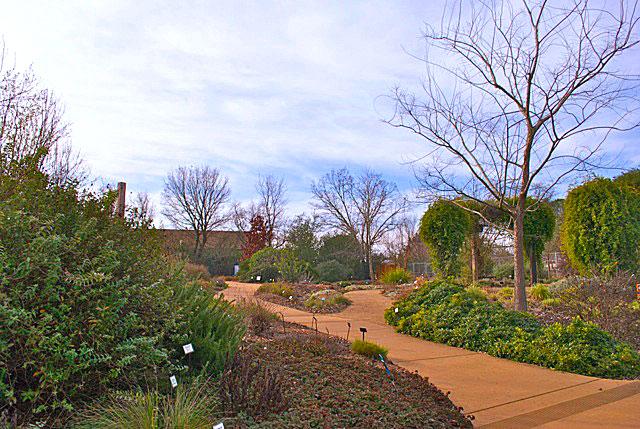
Especially lovely now are the the winter blooming Grevillea lanigera 'Coastal Gem' (a low growing evergreen spreading shrub from Australia), early blooming narcissus, and cloaking scarlet oak leaves (the scarlet oak leaves drop only when pushed off by young spring leaves).
In the native garden, evergreen manzanita, ceanothus, toyon, and pigeon point coyote bush shrubs are especially attractive (another reason to plant natives...they shine in the winter!). Other evergreen winter charmers are early blooming rosemary and bush germander (Teucrium fruitcans, a UC Davis All-Star). See pictures and cultural information about these and other plants that look especially lovely during this season on the winter plant list.
Winter pruning, especially ornamental grasses, will be our primary task this month. Withered grasses should be cut down to 4 to 6 inches above ground before they start vigorous spring growth. Watch our grass pruning video on YouTube, and download caring for ornamental grasses (PDF 88KB). Many salvias, including the UC Davis All-Star autumn sages, need to be reduced by at least a third. For tips, watch our salvia pruning video on YouTube. Daylillies will be divided, and barberry, santolina, plumbago and verbena shaped up. Get more cultural tips on caring for trees, shrubs and woody perennials.
Other winter tasks include removing early germinating weeds such as bedstraw, annual grasses and cut-leaf geranium, and renewing the organic mulch to depths of 4 to 6 inches. Find more information on mulches.
The WEL gardens feature natives, commonly available perennials, trees and shrubs, and plants from other Mediterranean climates that do well with less water during our long, hot, dry summers and tolerate our chilly, damp Sacramento County winters. Most plants are labeled and many are UC Davis Arboretum All-Stars.
Pathways, patios, raised planters, drip irrigation, a dry creek bed and permeable pavement demonstrate water wise, sustainable alternatives for gardeners who are considering replacing or reducing their lawns.
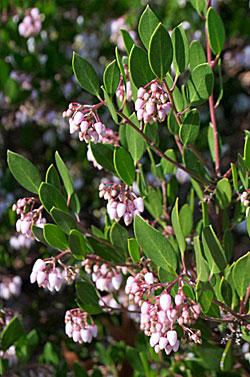
|
Arctostaphylos densiflora ‘Howard McMinn’ This durable, California native, UC Davis Arboretum All-Star, upright shrub with handsome red bark, glossy leaves and winter blooming delicate pink blossoms does well in our native demonstration garden. It accepts a wide variety of soils, handles pruning, can be grown in part shade, requires little summer water, and attracts hummingbirds and beneficial insects. Can grow 6 to 8 feet high by 6 to 8 feet wide. |
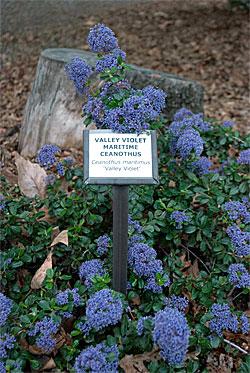
|
Ceanothus maritimus 'Valley Violet' The UC Davis Arboretum calls this low growing California native evergreen shrub “the best small ceanothus for central valley gardens”. A showstopper in winter gardens with spectacular clusters of dark-violet flowers from February to early spring that attract beneficial insects and butterflies, ‘Valley Violet' is a good choice as a groundcover for sunny and partially shady areas. Once established (which may take 2 to 3 years), it requires very little water and pruning. Tolerant of many soil types, it also is wind resistant, and heat and cold tolerant. Although we have several plants throughout the garden, it is especially lovely at the top of the perennial pathway near the scarlet oak on the edge of our native garden area (where it gets very little summer water). |
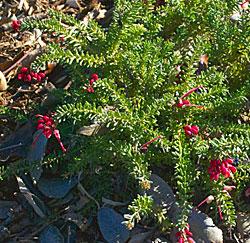
|
Grevillea lanigera 'Coastal Gem' Blooming as early as December and through winter into spring this low growing (1 foot tall by 4 feet wide), evergreen spreading shrub from Australia is extremely drought tolerant. It is also deer resistant. Sometimes known as “woolly” grevillea due to its soft, gray green leaves, it makes a good border, rock garden or ground cover plant. We have it planted on a slope (to improve drainage) at the entrance of our perennial path. Preferring full sun and neutral to slightly acidic fertile well drained soil, it can also handle some light shade in our climate. |
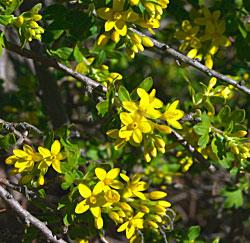
|
Ribes aureum var. gracillimum Bright green foliage and cheerful yellow clustering 1 to 1½ inch blossoms adorn this winter blooming, summer-deciduous native currant and UC Davis Arboretum All-Star. Sprawling up to 10 feet tall, the shrub naturally occurs on slopes below 2500 feet primarily in Southern California. The flowers and subsequent translucent yellow, orange, red and black berries attract birds, butterflies and beneficial insects. Preferring well drained soil, and suitable for planting under native oaks, it does well with some partial shade and light summer watering. Golden current spreads readily via rhizomes, layering stems and seedlings started from bird droppings and some pruning is needed to control the plant’s outreaching habit. It looks lovely as a companion to the concurrently blooming blue ceanothus. |
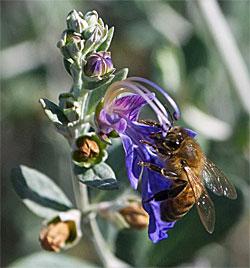
|
Teucrium fruticans 'Azureum' This UC Davis Arboretum All-Star shrub starts blooming in January just in time to attract early foraging bees and other pollinators on warm days. Extremely durable, disease free and drought tolerant, this western Mediterranean small shrub with gray green leaves and a long fall/winter/spring blooming season can be pruned as a low hedge or used as an accent plant. The lovely purple/lavender blossoms attract many beneficials. It is blooming now in our common variety garden. |



